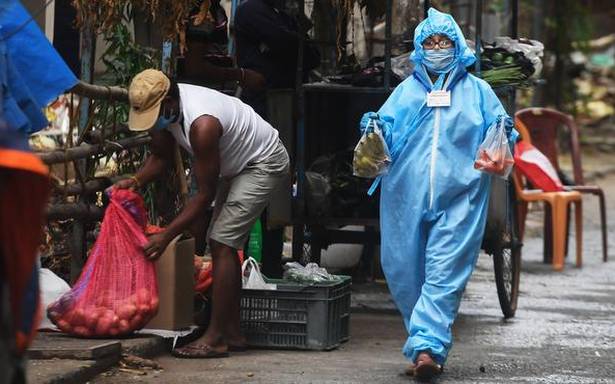On March 17, West Bengal recorded its first case of COVID-19 when an 18-year-old student, who had returned from London, tested positive for the virus. The student had been admitted to the Infectious Diseases and Beliaghata General Hospital, located about a kilometre away from the Eastern Metropolitan bypass in Kolkata. Despite being thrust into the limelight, the primary referral hospital for COVID-19 cases remained quiet. People continued to walk in; the guards did not stop anyone. They did not even object to a television crew that headed to the building later that night.
The next morning, however, there was frenetic activity at Nabanna, which houses the State Secretariat, when it became public knowledge that the student was the son of a senior official in the State Home Department. The student had been in contact with his parents and his driver after his return to India on March 15. His mother had attended office till March 17 and met senior officials, including the Home Secretary of West Bengal. To make matters worse, reports said that the student had delayed his visit to a testing centre and had visited a shopping mall in the city, despite government instructions that those returning from abroad must remain in quarantine for 14 days. Several officials were furious about this serious and dangerous lapse of judgment.
Interactive map of confirmed coronavirus cases in India | State Helpline numbers for COVID-19
Changing bulletins
Nearly a week later, on March 23, West Bengal recorded its first COVID-19-related death when a 57-year-old succumbed to the virus. The case was a matter of concern as it was unclear where the man, a resident of Dum Dum and an employee of the Eastern Railways, had contracted the virus. His family denied Chief Minister Mamata Banerjee’s statement that he had travelled abroad. The confusion over his travel history also reflected in the Heath Department’s official bulletin: it simply did not say anything about his travel history. In fact, from that day onwards, the Health Department, in its bulletins on COVID-19, stopped carrying any details about the travel histories of the infected and dead. The daily bulletin, which was first released as early as February, was initially an important tool for keeping the people informed. However, as cases grew in the State, the bulletins were constantly altered — sometimes to omit certain details and at other times to add details. This not only caused confusion and panic, but also raised eyebrows about the government’s handling of the crisis.
This was surprising given how Banerjee appeared to be making all the right moves in the beginning of the outbreak. Between the time of the first reported COVID-19 case and the first COVID-19-related death in West Bengal, the government issued dozens of notifications and orders. The most significant one was issued on March 22. Titled ‘Complete Safety Restriction’, it announced a complete lockdown in West Bengal from 5 p.m. on March 23, a day before Prime Minister Narendra Modi announced a nationwide lockdown. A meeting of major political parties was called to discuss ways of fighting the deadly virus. The Chief Minister demanded special packages from the Centre and visited markets and hospitals. An image circulating on social media at the time showed her drawing circles on the road in front of a shop to demonstrate to people how to practise physical distancing. Regular meetings with senior health and district officials were broadcast live on local television news channels. The State government announced a ₹200 crore fund and urged people to donate to the State Emergency Relief Fund that had been set up to contain the crisis. Quarantine centres were set up in every district. A separate COVID-19 hospital was identified and made functional. The police appeared to be enforcing the lockdown strictly by arresting hundreds of violators in Kolkata alone.
Coronavirus | As death toll rises Bengal government says those reportedly tested positive are subject to confirmation
Setting up a task force
But in the last few days of March, it became clear that the virus had spread to different parts of the State: a resident of Kalimpong in North Bengal died, several in Howrah succumbed to the infection, and Purba Medinipur and Nadia districts also registered cases. Between March 31 and April 2, the death toll jumped from two to seven. Those who had died had no confirmed travel history outside the country.
On April 2, a committee of doctors engaged by the State government as a Special Task Force against COVID-19 met at the State Secretariat and announced that the death toll had increased to seven. However, within an hour, the government revised the number. Chief Secretary Rajiva Sinha said that the death toll was not seven but three, as four people who had died were admitted with “co-morbidities”. On April 3, the West Bengal government issued a notification announcing that an expert committee would be set up for “conducting audit of the suspected deaths due to COVID-19”. The committee’s task was to audit all those people who had died after testing positive for the virus and examine “whether they died of the viral infection or co-morbidities”. The two terms, ‘audit committee’ and ‘co-morbidities’, came to dominate the discourse on the pandemic in West Bengal over the next few weeks.
Also read | Howrah station turns into “hellhole” for hundreds of stranded passengers
More and more reports of COVID-19-positive patients dying were published in the media, but the official death count remained low. This was because the audit committee was busy examining each and every case. The figures were updated only with its approval. Journalists, doctors and Central teams began raising questions about the committee’s method in arriving at the

